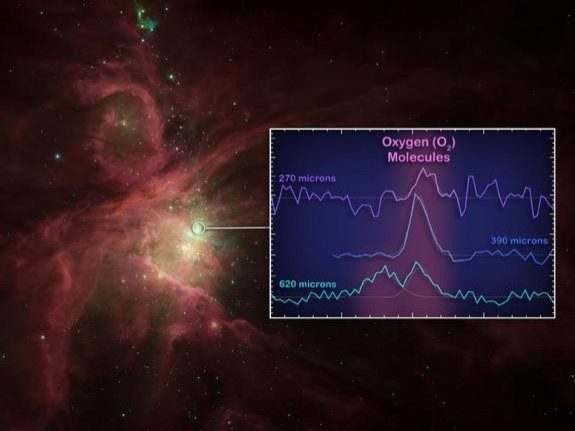Astronomers Find Elusive Oxygen Molecules in Space

Astronauts looking for a breath of fresh air have to invariably return to Earth. However, there is now the second option of traveling some 1,500 light years to the Orion Nebula, where oxygen molecules have been detected for the first ever time in space.
Scientists have discovered the first ever molecules of oxygen deep in space in a region of the Orion nebula, which ended a mystery lasting 230 years regarding oxygen in space.
The discovery was made with the European Space Agency's (ESA) Herschel Space Observatory, which used its large telescope and infrared detectors to find the elusive molecules.
Atomic oxygen (individual oxygen atoms) is common in space, especially near huge stars. But this was the first time that astronomers located molecular oxygen, which is formed of two bonded oxygen atoms and makes up about 20 percent of the air we breathe on Earth.
"Oxygen gas was discovered in the 1770s, but it's taken us more than 230 years to finally say with certainty that this very simple molecule exists in space," said lead author Paul Goldsmith, NASA's Herschel project researcher at the agency's Jet Propulsion Laboratory (JPL).
Oxygen stored in ice particles coating tiny dust grains, common in this region in space, are heated up when new stars form. As the icy grains are warmed, Goldsmith explains, water discharges, forming molecular oxygen in the dense gas clouds.
Goldsmith emphasized that confirming their existence does not answer questions about how the molecules were formed, or why they found them where they did.
"This explains where some of the oxygen might be hiding. But we didn't find large amounts of it, and still don't understand what is so special about the spots where we find it. The universe still holds many secrets," said Goldsmith.
"The discovery of at least part of the 'missing' interstellar oxygen is a remarkable result achieved by Herschel," said Göran Pilbratt, ESA Herschel Project Scientist, in a statement.
He concluded that "more observations of other molecular clouds are planned, and we are eagerly awaiting the results of this on-going search for one of the most elusive molecules in space."
The discovery caps decades of research, as astronomers employed balloons and telescopes to confirm their belief that oxygen molecules exist in space. The molecule was spotted in 2007 by the Swedish Odin telescope but has not been confirmed until now.
With this discovery, scientists will begin exploring other star-forming regions for more oxygen molecules.
© Copyright IBTimes 2024. All rights reserved.





















